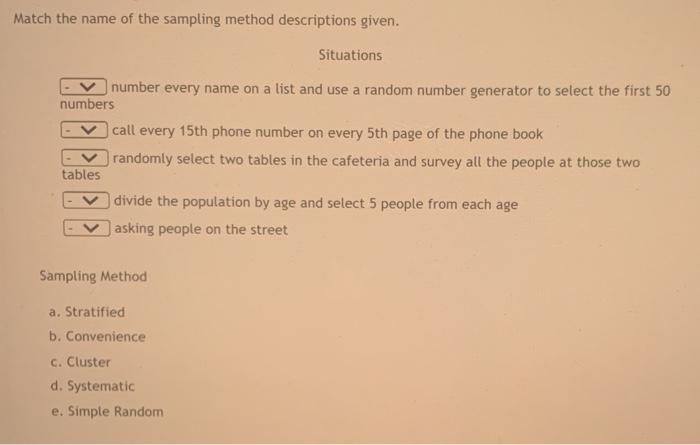Match the name of the sampling method descriptions given – In the realm of research, sampling methods play a pivotal role in data collection. Understanding the nuances of each method is crucial for researchers to make informed decisions and ensure the validity of their findings. This guide presents a comprehensive overview of sampling methods, providing detailed descriptions, advantages, disadvantages, and practical applications.
From simple random sampling to more complex stratified and cluster sampling, this guide covers a wide range of techniques. Each method is thoroughly explained, highlighting its strengths and limitations. The discussion also delves into the factors that influence the choice of sampling method, ensuring that researchers can select the most appropriate technique for their specific research objectives.
Sampling Methods: Match The Name Of The Sampling Method Descriptions Given

Sampling methods are techniques used in research to select a representative subset of a population to make inferences about the entire population. There are various sampling methods, each with its advantages and disadvantages.
When choosing a sampling method, researchers consider factors such as the population size, the desired level of accuracy, and the resources available.
Sampling Method Descriptions, Match the name of the sampling method descriptions given
| Sampling Method | Description | Advantages | Disadvantages |
|---|---|---|---|
| Simple Random Sampling | Each member of the population has an equal chance of being selected. | Unbiased, easy to implement | May not represent the population well if it is not homogeneous. |
| Systematic Sampling | Members of the population are selected at regular intervals. | Easy to implement, can be more representative than simple random sampling. | May not be representative if there is a pattern in the population. |
| Stratified Sampling | The population is divided into strata (groups) and members are selected from each stratum. | Ensures representation of different subgroups within the population. | Can be more complex to implement than other methods. |
| Cluster Sampling | The population is divided into clusters and members are selected from a few clusters. | Less expensive and time-consuming than other methods. | May not be representative if the clusters are not homogeneous. |
| Convenience Sampling | Members of the population are selected based on their convenience. | Easy and inexpensive to implement. | Highly biased, not representative of the population. |
FAQ Compilation
What is the most commonly used sampling method?
Simple random sampling is the most commonly used sampling method due to its simplicity and unbiased nature.
What are the advantages of stratified sampling?
Stratified sampling ensures representation from different subgroups within the population, leading to more precise estimates.
When should cluster sampling be used?
Cluster sampling is appropriate when the population is geographically dispersed or difficult to access.


